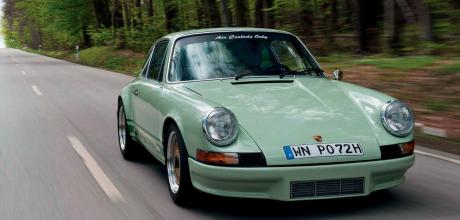Powered by a 210bhp 2.7-litre flat-six 1972 Porsche 911 S Restomod
They don’t come much more spick and span than Uwe Kraenzmer’s prized Porsche. Then again, we shouldn’t expect anything less from a marque enthusiast running a business stripping muck off vehicle chassis. His intriguingly named 911 got the full treatment… Words Johnny Tipler. Photography Antony Fraser.
CLEAN-UP OPERATION
An intriguingly named 1972 Porsche 911 S Restomod
Actors. What are they like?! We have James Dean and his 550 Spyder, known as Little Bastard. In The New Statesman, Rik Mayall famously played Alan B’Stard MP. Even Leonardo DiCaprio has got in on the act, starring in Quentin Tarantino’s war movie, Inglourious Basterds. As for our feature car, dirty rotten bastard? Not this one! It may have been born out of wedlock, but it’s pretty damn clean. What’s more, there is absolutely no corrosion to speak of. Tidy performance too, as we shall see. But what’s the story behind this enigmatic 911, posing as it does like an early 1970s hot rod?

Cruising the vintage vehicles on display at the Retro Classics show in Stuttgart, we’re attracted by this intriguingly hued 911, oddly positioned on an exhibition stand with its back wheels mounted on a plinth and a mirror beneath the chassis. We peer at the looking-glass, expecting to see a fancy exhaust reflected, but the point — as we immediately discover — is to demonstrate the car’s entire underside and running gear being absolutely eat-your-dinner-off-it pristine. The Porsche’s owner, Uwe Kraenzmer, is a saubermacher. Translated into English, this means he’s the clean-up guy, and we’ll get to that in a moment. Beforehand, we’ll address another rather more obvious conundrum: where you’d normally get the traditional Carrera hieroglyphs running along the flanks of an RS 2.7, this car carries the somewhat derogatory Bastard moniker.
ITS ORIGINS MAY BE A LITTLE CLOUDY, BUT THIS 911 CAN SHOW MOST OTHER SPORTS CARS A CLEAN PAIR OF HEELS
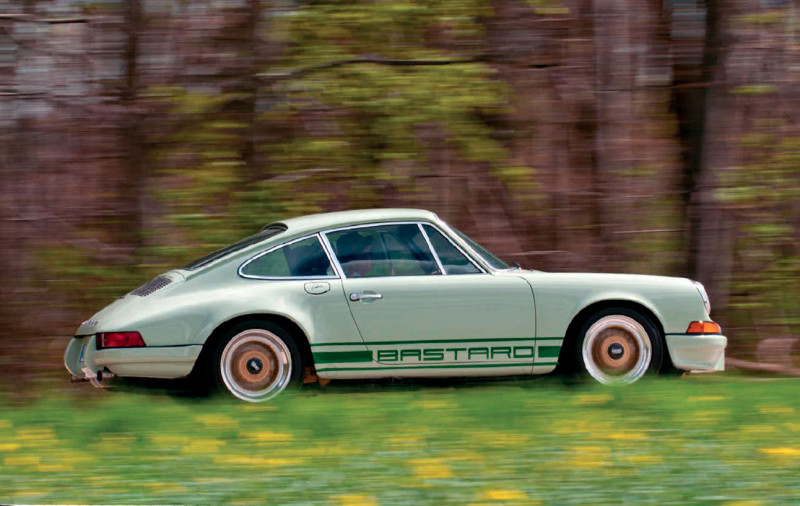
To be frank, if it’s good enough for James Dean, it’s good enough for the rest of us. Dean named his 550 Spyder Little Bastard in direct reference to the nickname given to him by his dialogue coach in the Warner Bros. studios in Hollywood. Our friend Uwe — rhymes with Hoover — applied much the same nomenclature to his 911. Why? Because the componentry installed during its restoration hails from a number of different sources, scrambling its true parentage. Some folk might consider the word bastard an abusive term, but Porsche deity, Walter Röhrl, is not one of them, having happily autographed the car’s oil-tank trap-door.
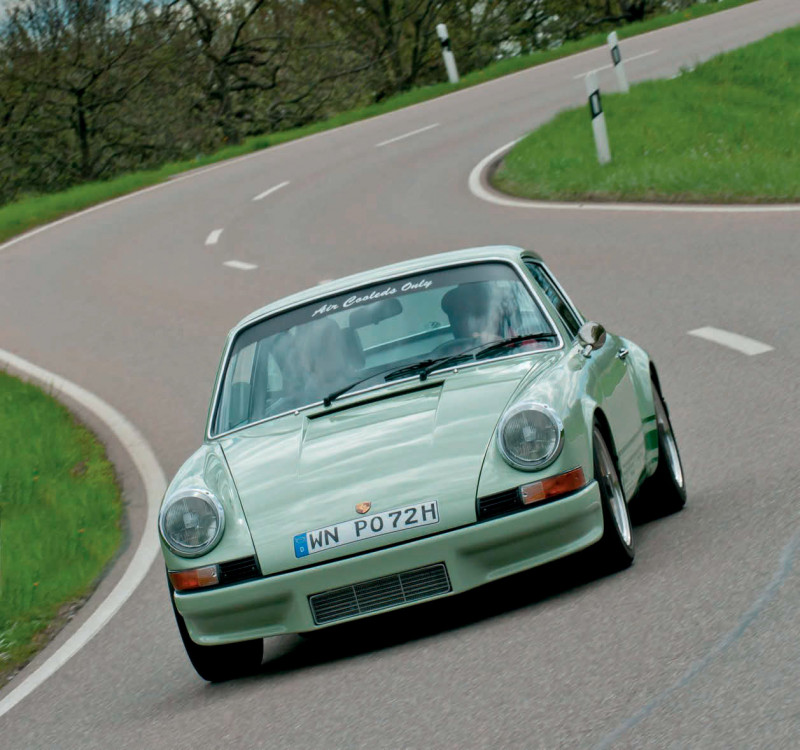
AMERICAN IDOL
Ah, there’s a clue as to the date of manufacture — of the bodyshell, at least. This particular orifice was only present for the 911 during the 1972 model year. Ostensibly, Uwe’s Bastard is a characterful mellow green 911 which began life as a 2.4-litre E-programme 911 S, first registered in the USA in January 1972. The subtle eau-de-nil colour was adopted from an RSR the car’s previous owner had seen racing in America. During the course of the repaint, the rear wings and wheel arches were broadened by a subtle three centimetres each side, using welded-on extensions sufficient to accommodate those splendid period-look BBS split rims.
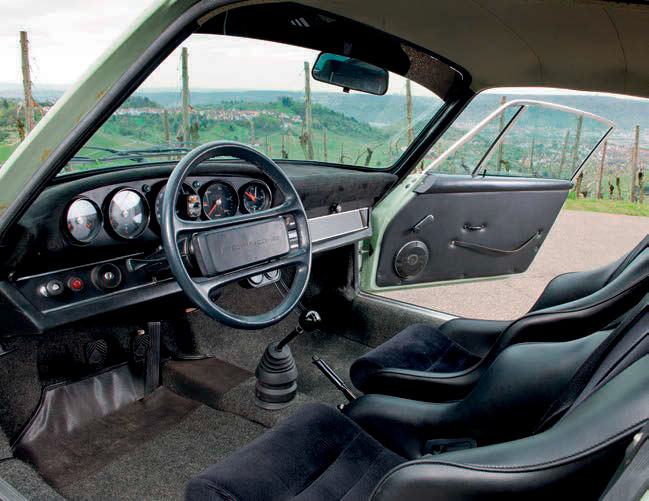
“The updated G-series 911 for 1976 was a little broader in the rear wings,” Uwe points out. “The same modification has been made to this car.” He’s very fond of referring to the various build programmes identifying the evolutionary phases of 911 construction and specification. And indeed, the wings or fenders ushered in with the G-programme’s impact bumpers and galvanised chassis have the perverse effect of popping it back in time, bestowing it with the more purposeful stance of an S/T from 1970 or 1971. Actually, Bastard is endowed with almost the same power potential as an S/T, certainly the same as an RS 2.7. This is because, in 2006, after standing idle for some time, this mean, green 911 was equipped with a 210bhp 2.7-litre flat-six (911/83) fed by mechanical fuel injection and coupled with a five-speed 915 gearbox. This is the same unit as found beneath the ducktail of an RS 2.7, though in all probability, the RS’s Nikasil barrels had, by this engine’s manufacturing date of 1975, been superseded by diecast AluSil barrels needing no cylinder liners, together with cast-iron piston skirts.
The badge on the rear deck proclaims the car to be a Carrera, and I suppose it does qualify up to a point — it’s a Carrera engine, after all — though the 2.4 shell and chassis number rather negate this claim. Do you see now why the Bastard epithet has a ring of truth about it? The running gear is similarly muddled, though no less effective: Bilstein dampers complement the 6J and 7J centre-lock wheels, which are wrapped in Pirelli P-Zero 205/55-ZR16s up front and fatter 225/50-ZR16s at the back, beautifully filling the arches. At nose and tail, fibreglass RS-style bumpers and valances feature prominently, though there’s no RS engine lid adornment. Inside, even the suede-clad dashboard is plastic, possibly replacing a sun-cracked original, though the gauges are mostly original. The steering wheel, meanwhile, was originally fitted to a donor Carrera 3.2.
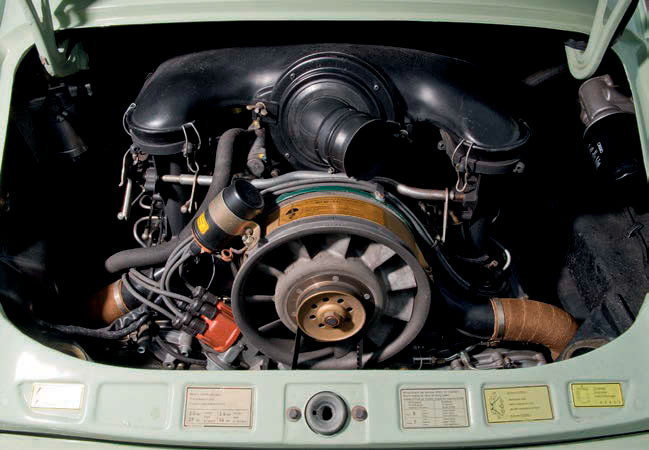
Bastard was formerly the property of a Porsche racing mechanic. It replaced a 964 Cabriolet in Uwe’s garage. Much of the fundamental work was already done when he bought the car in 2011, though he and his wife Ute — more or less rhymes with Utah — then spent close to two thousand hours perfecting it. One of the big lessons he learned was how used classic parts often cost more than brand-new replacements, which partly explains the jumbled inventory. “It’s better to buy new parts where possible,” he reckons.
“Used classic spares can prove much more expensive. Thankfully, you can get most of the new parts you need direct from Porsche Classic and many independent retailers.” I suppose being on Porsche’s Stuttgart doorstep helps a bit, too.
TWO MAKES A TEAM
The bulk of the finishing-off took place at Uwe’s car cleaning premises at Fellbach, just to the northeast of Stuttgart. It’s not any old valeting vacuum centre — it’s a serious saubermacher service. Uwe goes the whole hog, using dry ice to literally blast crud off the underside of vehicles. And that’s what gave Bastard such a good start in his possession. There’s no question of its owners’ marriage credentials, either — Mr and Mrs Kraenzmer are very much a working partnership.
We found Uwe and Ute hard at work beneath a 928 up on the ramp in their workshop, a lofty single-storey building with floor-to-ceiling windows and a long draping curtain. Both unswervingly charming, the Kraenzmers gave us a demonstration of how amazingly effective dry ice blasting is. Oh, and we were treated to a chemistry lesson too. Here comes the science.
Unlike shot-, bead- or sand blasting, dry ice is less forceful, though no less effective. It is essentially carbon dioxide in solid form and achieves the stripping goal by slightly different means — the dry ice pellets are relatively soft, not dense like sand or shot, and they ‘sublimate’ or liquefy faster on the surface being cleaned, the resulting heat transfer setting up a thermal shock triggering a layering of the surface deposits, causing them to flake off. There’s also a side effect in which microscopic shock waves set up as the matter changes from solid state to gas in order to help remove the deposits. Clad in protective overalls, Uwe and Ute are armed with pressure hoses and a copious arsenal of dry ice pellets capable of servicing an entire Judas Priest tour. The system employs compressed air to propel the pellets onto the underside of the vehicle. The purging effect is remarkably thorough, making elements of the V8-powered Porsche look like new. Additionally, the process itself is ‘pure’, meaning there’s no chemical residue left behind. The catering industry uses a similar dry ice method for sanitising greasy kitchens. It’s hardly glamorous, certainly compared with the sparkling 911 that Uwe is in possession of. “It’s really dirty work,” he says, all masked up. “It’s also very loud, which is why we cover our ears.”
FLAVOUR OF THE WEEK
It takes between eight and ten hours for the treated surface to dry, after which, a protective wax coating is applied. Taking into account preparation such as blocking up holes in the floor to ensure the CO2 doesn’t permeate the cabin interior, the full treatment takes a week. In any case, Uwe and Ute treat the metalwork a centimetre at a time — it’s nothing like using the pressure hose at your local car wash.
As part of the service, Uwe supplies customers with dramatic ‘before’ and ‘after’ photos. The procedure will almost inevitably reveal aspects of the vehicle’s chassis and running gear in need of further attention from other trades — the Kraenzmers spoke of cars with floor pans resembling sieves once underseal had been removed. This isn’t their concern, though customers are made aware of the possibility of what might be revealed. And in case you were wondering, Uwe’s dry ice saubermacher process costs between €500 and €900, depending on the condition of the car to be treated and how much preparation work needs to be carried out, including the time-consuming process of removing extraneous trim. As for our subject 911, the only patches to speak of concern the car’s history. Uwe knows his Porsche came to Europe in 2000 and passed from the Netherlands to Germany in 2009. He’s now owned it eleven and a half years. At the time of our meeting, he’d only covered three thousand kilometres and was still running-in the rebuilt 2.7-litre engine. Many small details were taken care of in the refurbishment programme, including the fitting of a new rev counter and the more recent fourbar steering wheel. There’s an additional pair of voltage and oil temperature gauges, plus a programmable shift light on the tachometer. Away from the uprated dampers, original 2.4 suspension components were updated with forged rear semi-trailing arms (lighter and stiffer than fabricated steel items) and fatter anti-roll bars. The brakes were upgraded to 911 Turbo (930) items, while the exhaust system is also a 930 part.
The aforementioned front bumper might be a fibreglass 2.7 RS facsimile, though the oil cooler is of 2.5-litre S/T specification. The lone Durant door mirror is from the 1972 911 S. The horn grilles on the front of the car are correct matte-black for the same period. Climb inside and the cabin is distinguished by new carpeting, lightweight door cards, RS-style leather-thong pull cords, wind-up window handles, the previously mentioned suede-trimmed dash and a pair of leather bucket seats with smart corduroy centres. There’s no roll cage, but there’s a brace running between the B-pillars, useful as a harness rail. Across the front suspension turrets, we spot a welded-in strut brace. We agree, all of this sounds like a bit of a hotchpotch, but the overall presentation and drivability of the car mark it out as something rather special. Endearing, even.
“There are so many changes to this Porsche’s original specification. It’s why the car is named Bastard,” Uwe smiles. “It’s an interesting and ambiguous composition, and although I didn’t implement the major upgrades, I have perfected the car by restoring whatever aspects of it I deemed in need of attention.” His work was followed by the extensive running-in period, which seems to be ongoing. At least the undulating countryside around Fellbach provides plenty of scope for easing this aircooled Porsche’s engine into new life.
FAMILY AFFAIR
This is, in fact, Uwe’s second 911. He’s always been a car buff — he worked for Mercedes-Benz in Stuttgart for thirty years and then set up his saubermacher operation with Ute almost two decades years ago. Their daughter, Tabatha, has also caught the Porsche bug. “She loves riding in the 911,” he laughs. “The faster the car, the better. She always comes along to Porsche club or Nürburgring Old Timer meetings with us. She will probably train to be a mechanic at either the Porsche or Mercedes factory.” Both establishments are nearby, of course, such are the perks of close approximation to Stuttgart, though you don’t have to go far to get rural —Solitude road-race circuit and Weissach are only just a few kilometres away.
Bastard is Uwe’s pride and joy. When he’s happy the engine has been sufficiently run in, he will contemplate weekend trackday action. In the meantime, we can have a little fun teasing the car ourselves. We drive out of Fellbach and wind our way up into the hilly vineyards overlooking the old Mercedes test track and Arena at Untertürkheim, way down below in the orbit of the Stuttgart metropolis. This 911 sounds as gorgeous as it looks, rasping flat-six snarling on the overrun as we throttle back for the bends, blaring again as we power around them. Bastard? This 911 doesn’t deserve the appellation one little bit! As for the ride and handling, there’s no roll, and the Porsche’s behaviour around the ups and downs of these Baden-Württemberg country hairpins is exemplary, just as you’d expect from an early 1970s 911 with nailed-down suspension componentry and the clout of an RS motor.
Its origins may be a little cloudy, but this 911 genuinely drives like an RS 2.7 and can certainly show most other contemporary sports cars a clean pair of heels, in more ways than one. It’s a great, characterful air-cooled Porsche delighting just as visually as it performs, which is quite a transition aesthetically and mechanically from the 2.4-litre E-programme car it started out as. Everything marries up nicely, which, ironically, renders the Bastard epithet somewhat erroneous. An oxymoron, if you will. James Dean might have appreciated the humour, but I think I’d want to name this 911 something in recognition of its current custodian, the saubermacher. How about a Sauber-Porsche? No?
Above Another fantastic example of an early 1970s 911 with power and handling rivalling the Carrera RS 2.7, but without the price tag.
Above Uwe blasts cars with soft dry ice pellets to reveal metal hiding beneath layers of decades-old dirt — during our visit, his workshop featured a 928 waiting for the treatment, which had just been applied to a Mercedes-Benz W113 280 SL ‘Pagoda’ to great effect…
Above Tipler does his best James Dean impression.
Below Two-time WRC champ and Porsche test driver, Walter Röhrl, autographed the Bastard’s oil filler flap.


